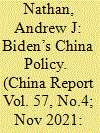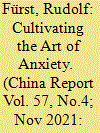| Srl | Item |
| 1 |
ID:
182595


|
|
|
|
|
| Summary/Abstract |
The Biden Administration has accepted the Trump Administration’s definition of China as a ‘strategic competitor’, and has retained Trump’s tariffs, the ‘Quad’, and the upgrade in Taiwan’s protocol status. But Biden’s China policy is different from Trump’s in being truly strategic. The key elements of that strategy are focused on improving the United States’ competitiveness domestically and in international affairs; cooperation with allies and partners; an emphasis on human rights; partial decoupling of economic and technology relationships; and a search for some areas of cooperation with China. Success for the Biden strategy would consist neither of bottling up China in its current global power position nor in achieving a negotiated condominium in Asia. The Biden Administration would succeed if the United States can maintain its alliance system, keep a robust military presence in East Asia and prevent the forcible integration of Taiwan into China while avoiding major war. Several features of the China challenge make it reasonable to hope that such success is possible.
|
|
|
|
|
|
|
|
|
|
|
|
|
|
|
|
| 2 |
ID:
182598


|
|
|
|
|
| Summary/Abstract |
Deepening globalisation and worldwide availability of free information and ideas raise concerns of the communist China’s political leadership about the stability of the regime and the sustainability of the state ideological orthodoxy. Therefore, the state’s tightening control of the public communication to curtail the domestic criticism and occasional public discontent is becoming framed and legitimised in terms of cultural security as a non-traditional security concern. This study argues that the restrictive impacts of the politicisation of culture in the centralised agenda of President Xi Jinping reinvigorate China’s anti-Western narratives and attitudes. The research focuses on the state’s cultural security-related and applicable strategy in the political and institutional agenda and media. Moreover, the study also traces the state cultural security policy in the field of the civic and non-governmental sector, religious and ethnic minorities policy, literature, film and audiovisual sectors. The findings assess the concern that the intellectually anachronistic, self-restraining and internationally hostile policy devaluates China’s cultural potential and complexity.
|
|
|
|
|
|
|
|
|
|
|
|
|
|
|
|
| 3 |
ID:
182597


|
|
|
|
|
| Summary/Abstract |
China has responded to criticisms of its handling of the COVID outbreak by an assertive foreign policy style referred to as ‘wolf-warrior diplomacy’. This study argues that this does not represent a radical shift in Chinese foreign policy but exacerbates a pre-existing trend. We say that this assertiveness builds upon the twin pillars of ‘core interests and the unambiguous exposition of the ‘striving for achievement’ policy adopted by China since Xi Jinping’s elevation as the President in 2012. We outline China’s response to its competition with the United States, based on heightened nationalism and practiced through centralised decision making.
|
|
|
|
|
|
|
|
|
|
|
|
|
|
|
|
| 4 |
ID:
182599


|
|
|
|
|
| Summary/Abstract |
The controversy surrounding the Simla Conference of 1913–1914 and the legality of the McMahon line, which was produced by the Conference, has been at the centre of the boundary dispute between India and China. Amidst the diverging opinions amongst scholars and political commentators, the main issue rest on the unresolved question of Tibet’s political status. Was Lhasa authorised to sign treaties for Tibet? Was China the sovereign over Tibet? The answers to such questions are murky and complicated, made more so by the politics and conflicts in the post colonial period. This study attempts to highlight the complicated nature of political authority in Tibet through a study of British policy in Tibet towards the end of 19th and early 20th centuries. The signing of the 1890 Convention with China and the 1904 Convention with Tibet represents two extremes in British foreign policy which attest to the confounding situation presented before the British and the diverging opinions within the British official circles. The period between these two conventions provides a glimpse of the historical background in which the relations between British India, China and Tibet developed subsequently.
|
|
|
|
|
|
|
|
|
|
|
|
|
|
|
|
| 5 |
ID:
182596


|
|
|
|
|
| Summary/Abstract |
This study illustrates the interaction of international and domestic factors that influenced China’s stance in the climate negotiations from 1992 to 2015. After providing a historical overview of China’s climate diplomacy, it elaborates on the external and internal factors that have shaped China’s climate diplomacy. At the international level, it examines the pressures that China has faced from both developed and developing countries at the United Nations climate change conferences. At the domestic level, it analyses three factors—China’s political system, its energy scenario and its environmental non-governmental organisations—that pushed China to soften its traditional positions. It ends with an elaboration of the interface of the international and domestic factors that have driven China’s shift away from blunt rejection of mitigation responsibility.
|
|
|
|
|
|
|
|
|
|
|
|
|
|
|
|